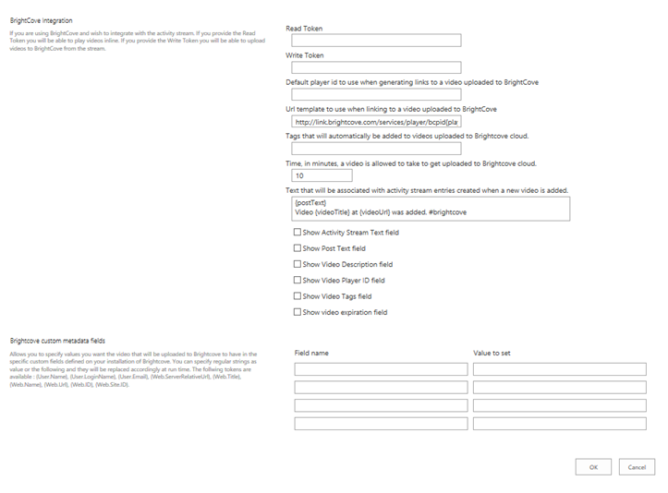Aurea Social Video Stream BrightCove integration
Integration with the BrightCove Video Cloud is configured in the Video Stream “Bright Cove integration configuration” page. From that page you can enter your read/write keys that allow you to access your BrightCove Video Cloud through BrightCove’s REST API.
Once you configure your read key, video links to your BrightCove videos can play inline in the activity stream. If you configure your write key, then a video upload icon shows up in the activity stream allowing you to upload a video to BrightCove.
Behaviors you can configure on that page:
- Read token: The read token associated with your account that gives you read access to your videos through the BrightCove REST API.
- Write token: The write token associated with your account that gives you the possibility to upload new videos to your BrightCove Video Cloud.
- Default player id: Allows you to configure which player is used by default to playback BrightCove videos. This can be changed by the user uploading a video if the “Show Video Player ID field” option is enabled.
- Url template: Allows you to define what the link to BrightCove videos that are to be played from the stream should look like. You have access to the following 2 replacement values from within the template:
{playerId}: The ID of the video player that is used.{videoId}: The ID of the video that is played.
- Time a video is allowed to get uploaded: This is the time in minutes the system allows for a video to get uploaded. If it takes longer that this time the upload is canceled.
- Text to be associated with activity stream entry: This the template of the text that is created as an activity stream entry once a video is uploaded to BrightCove Video Cloud. You have access to the following replacement values:
{postText}: Text the user adding the video can enter.{videoTitle}: The title given to the video.{videoUrl}: The url to get to the video. Note: for the activity stream to pick up the video and put an inline player for it the url to the video must be present.
- 7. Which non mandatory fields are made available on the video upload page.
- Shows Activity Stream text field: The complete activity stream text that is posted in the stream. As the admin you control what is posted, you also have a text field that allows you to enter what should be posted, but if you show this field the user can completely change it.
- Show Post Text field: Allows the user to input some text that is put in the activity stream text where the admin has specified the {postText} replacement value.
- Show Video Description field: The video description is not mandatory, you can choose to allow users to enter a description or not.
- Show Player ID field: Allows the user to specify the ID of the player to use to play the video that is being uploaded. If none is specified then the “Default Player ID” is used.
- Show Video Tags field: Allows the user to specify tags to add to the video. The tags are added both to BrightCove and Aurea Social.
- Show video expiration field: Allows the user to specify a video expiration date.
- Custom metadata fields. You can specify metadata fields you added to BrightCove and values you want set to them. Make sure the fields you configure here where previously created in BrightCove or you cannot upload your video. The values you can set are either a text value you enter directly or a replacement value in the form of {…} that is converted run time.
The set of replacement values are:
{User.Name}: Full name of the user adding the video{User.LoginName}: Aurea Social login name of the user adding the video{User.Email}: Email of the user adding the video{Web.ServerRelativeUrl}: Server relative url of the SharePoint web where the video was added from{Web.Title}: Title of the SharePoint web where the video was added from{Web.Name}: Name of the SharePoint web where the video was added from{Web.Url}: Full url of the SharePoiint web where the video was added from{Web.ID}: Id of the SharePoint web where the video was added from{Web.Site.ID}: id of the SharePoint site where the video was added from

BrightCove Video Cloud integration